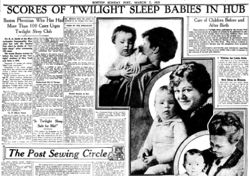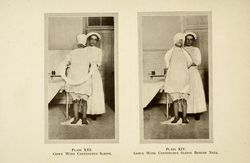Difference between revisions of "Why were women put into Twilight Sleep during childbirth"
(Created "What was Twilight Sleep") |
(No difference)
|
Revision as of 17:26, 19 December 2019
Twilight Sleep
As fields of inquiry, obstetrics and gynecology have a relatively short history. While obstetrics and gynecology have been practiced since time immemorial, their shift from women-centered knowledge and common sense practices to science began in the 19th century. Before the 19th century, much of the knowledge of childbirth and delivery was passed through women, kin, and midwives. As medicine became an organized profession in the 19th century, much of its early history revolved around consolidating that knowledge into medical men’s hands.[1]
With that, births went from being normal, everyday events, to illness-centered events requiring medical intervention. Once natural, with the dawn of medicine, childbirth became pathologized.
Though most women gave birth at home before the 19th century, the 20th century gave rise to maternity hospitals and more women gave birth with physicians in attendance. Dr. Joseph DeLee, author of the most frequently used obstetric textbook of the time Principles and Practice of Obstetrics, argued that childbirth was a process from which few women emerged unscathed. He believed that physicians needed to maintain control over the labor and delivery process through active protocols and medical interventions [2] Specialist obstetricians should sedate women at the onset of labor, allow the cervix to dilate, give ether during the second stage of labor, cut an episiotomy, deliver the baby with forceps, extract the placenta, give medications for the uterus to contract and repair the episiotomy. His article was published in the first issue of the American Journal of Obstetrics and Gynecology. All of the interventions that DeLee prescribed did become routine. By 1920, most doctors believed that "normal" deliveries were rare, and that doctors needed to be present to prevent trouble, and by 1921, thirty to fifty percent of women gave birth in hospitals.[3]
Twilight Sleep emerged at the beginning of the 20th century in this context. It was one of the most extreme measures available designed to allow doctors to remain in complete control during the childbirth process. In Twilight Sleep, mothers were drugged with morphine and scolpolamine--rendering them effectively unconscious throughout the birth process. This allowed the doctor to maintain control, but also had the additional benefit of rendering the childbirth painless. When the mother regained consciousness, she would have her child in hand, and no recollection of the delivery process.
Twilight Sleep was the product of two German physicians--Dr. Bernhardt Kronig and Dr. Karl Gauss. They developed the procedure in 1906 to alleviate the pain of childbirth. Their development did not occur in a vacuum. Twilight sleep "contributed to changing childbirth from an at home process to a hospital procedure and increased the use of anesthetics in obstetrics," and it was developed several years after Dr. Richard von Steinbüchel suggested the use of scopolamine as an anesthetic for childbirth.[4]
Morphine, a derivative of opium, was a well-known, powerful, (and addictive) narcotic with analgesic properties, and scopolamine was a "preanesthetic agent" that produced drowsiness, amnesia, and euphoria.[5] As medicine became a more organized and professional field, women increasingly asked for anesthetics during the childbirth process. Physicians were responding to these demands. When Dr. von Steinbüchel suggested the use of scopolamine (in conjunction with morphine) he wasn't hoping to render women unconscious, just to reduce pain. When the two drugs were injected, though, the combination of the two produced a result where women had no memory of pain. Drs. Kronig and Gauss reviited Dr. von Steinbüchel's formula and adjusted the dosage to avoid some of the negative--and potentially fatal--side effects, specifically: slow pulse and decreased respiration.[6] Kronig and Gauss posited that the use of this drug minimized complications and allowed mothers to recovery more quickly. While their initial findings were not well-received, they continued their research and soon started offering the procedure to some of Germany's wealthiest women.
Twilight Sleep was popular because it was thought to be a modern medical intervention, but also because it offered the potential for "painless" childbirth. However, the process was not actually painless. Women just had no memory of the pain. Their bodies still responded to pain and they still screamed, thrashed, and moved even while in a semi-zombie state. Pregnant women undergoing Twilight Sleep were thus restrained and placed in dark rooms while delivering.
This practice was limited to Germany for its first few years. In 1912, an American woman named Cecil Stewart went to Germany to deliver her child this way. She described it as a wonderful experience, and soon, other women became interested. Journalist for women's magazines read up on the procedure, sent pregnant women in to relay the process, and interviewed hospital staff.
Twilight Sleep soon became widely available in the US in 1914. However, its rise was short-lived. American physicians were not as well-versed in the proper dosages as more women demanded the procedure than physicians and nurses who were trained the administer them. In late 1915, Francis Carmody, a leading advocate for Twilight Sleep in the US, died while during Twilight Sleep--though others would later say the death was unrelated to the procedure itself.
Though Twilight Sleep fell in popularity, it was still available. In 1958, however, an article called "Cruelty in Maternity Wards" by Ladies Home Journal exposed some of the violence that was occurring in modern American delivery rooms. The author described the leather restraints and screaming that the women under the influence had no memory of. Some have described this as an important moment in the history of childbirth, as it was, after this encouraged for fathers to be present at deliveries where they had been absent before. This was also true for the women. When they were administered this particular drug cocktail, they, too, were absent from the childbirth experience.
This image of restrained women during childbirth--a natural process--especially at the hands of predominantly male physicians did not bode well with the forthcoming Women's Rights Movement. Subsequent pharmaceutical innovations have found a way to minimize the pain of childbirth while also allowing women to be present to welcome the birth of their new child.
- ↑ Pablo Mitchell, Coyote Nation: Sexuality, Race, and Conquest in Modernizing New Mexico, 1880-1920 (Chicago: The University of Chicago Press, 2005), p. 122-148.
- ↑ Lynette A. Ament, Professional Issues in Midwifery (Sudbury: Jones and Bartlett Publishers, 2007), p. 23.
- ↑ Richard Wertz and Dorothy C. Wertz, Lying-In: A History of Childbirth in America (New Haven: Yale University Press, 1989)
- ↑ Jessica Pollesche, "Twilight Sleep," The Embryo Project, 2018 [1].
- ↑ William C. Shiel, Jr. "What is Twilight Sleep in Obstetrics?" MedicineNet, 2018 [2].
- ↑ Pollesche.
Additional Sources
Stella Lehr, "A Possible Explanation of the Conflicting Reports on Twilight Sleep.” California State Journal of Medicine 8 (1915): 220–22.
Judith Pence Rooks, Midwifery and Childbirth in America.
Mark Sloan, Birth Day: A Pediatrician Explores the Science, the History, and the Wonder of Childbirth. Paul Starr, The Social Transformation of American Medicine.

